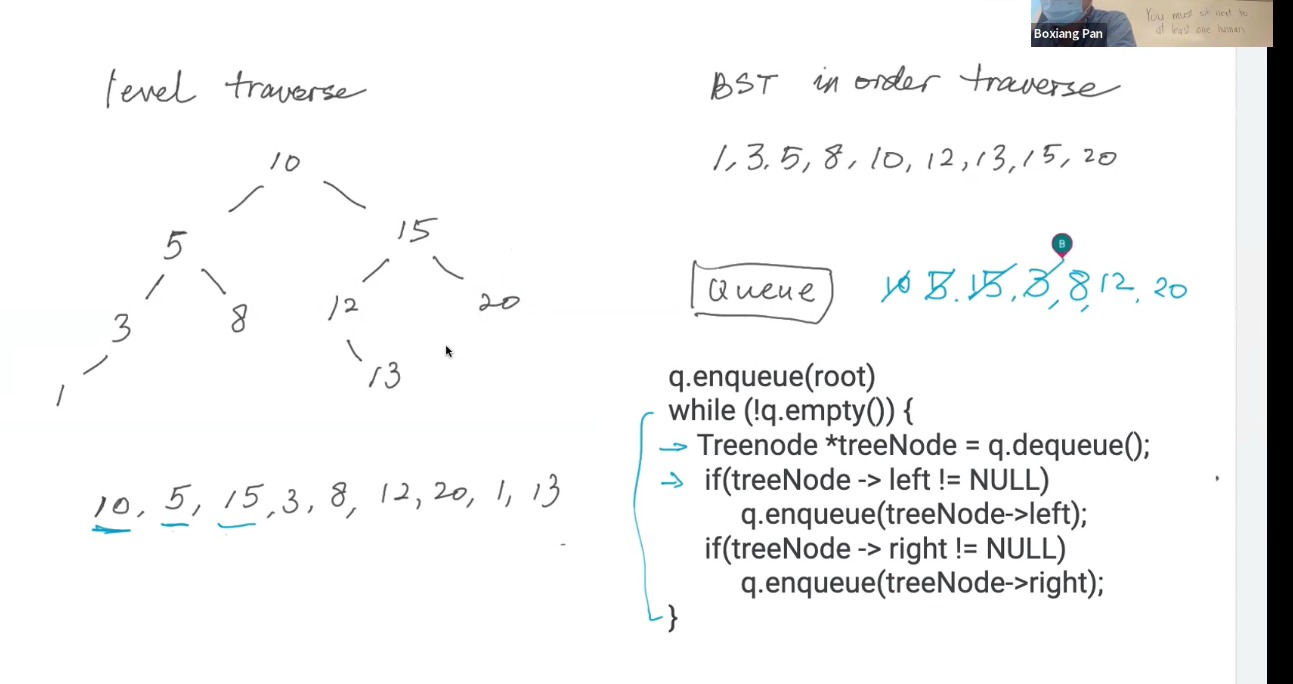Tree Traversal

There are 3 main traversal types for trees
Pre-Order Traversal
The tree will first read the root, then the left child, then the right child.
Pre-Order Snippet
traverse(TreeNode *root){
if(root == NULL) return;
traverse(root->left);
traverse(root->right);
}
In-Order Traversal
The tree will read the left child, then the root, then the right child.
In-Order Snippet
traverse(TreeNode *root){
traverse(root->left);
if(root == NULL) return;
traverse(root->right);
}
Post-Order Traversal
The tree will read the left child, then the right, then the root.
Post-Order Snippet
{
traverse(root->left);
traverse(root->right);
traverse(TreeNode *root)
if(root == NULL) return;
}
Level Ordered Traverse
In a level ordered traverse, you're visiting level by level. To do this, we need to employ a FIFO Data Structure. In this case, we will be using a Queue.
Level ordered traversals are Breadth First Search
We cannot restore the tree with this

Level Traverse Snippet
q.enqueu(root)
while(!q.empty()){
Treenode *treeNode = q.dequeue();
if(treeNode ->left !=NULL){
q.enqueue(treeNode->left);
};
if(treeNode -> right!=NULL){
q.enqueue(treeNode->right);
};
}
With the above code however, we don't know how deep the tree goes. We need a tracker for the queue size
q.enqueu(root)
int level = 0
while(!q.empty()){
int sz = q.size();
for(i=1,i<sz,i++){
Treenode *treeNode = q.dequeue();
if(treeNode ->left !=NULL){
q.enqueue(treeNode->left);
};
if(treeNode -> right!=NULL){
q.enqueue(treeNode->right);
};
}
level++
}
LeetCode Problem 26 - Remove Duplicates from Sorted Array Problems
104 Maximum Depth of a Binary Tree
https://leetcode.com/problems/maximum-depth-of-binary-tree/
Given the root of a binary tree, return its maximum depth.
A binary tree's maximum depth is the number of nodes along the longest path from the root node down to the farthest leaf node.
When we see a tree problem, usually there are 2 approaches:
- Traverse the Tree
int res = 0;
int depth = 0; //This is the depth of the current TreeNode
void traverse(TreeNode* root)
{
if(root == NULL){
//at leaf node, update the result
res=max(res,depth);
return;
}
depth++;
traverse(root->left);
traverse(root->right);
}
int maxDepth(TreeNode* root){
traverse(root);
return res
}
- Divide into sub problems(recursion)
int maxDepth(TreeNode *root){
if(root == Null){
//base case
return 0;
}
int leftDepth = maxDepth(root->left);
int rightDepth = maxDepth(root->right);
return max(leftDepth, rightDepth) + 1;
}
/**
* Definition for a binary tree node.
* struct TreeNode {
* int val;
* TreeNode *left;
* TreeNode *right;
* TreeNode() : val(0), left(nullptr), right(nullptr) {}
* TreeNode(int x) : val(x), left(nullptr), right(nullptr) {}
* TreeNode(int x, TreeNode *left, TreeNode *right) : val(x), left(left), right(right) {}
* };
*/
class Solution {
public:
int maxDepth(TreeNode* root) {
}
};
Since the return value is usually the answer to the problem, we use Post Order
543 Diameter of a Binary Tree
https://leetcode.com/problems/diameter-of-binary-tree/
Given the root of a binary tree, return the length of the diameter of the tree.
The diameter of a binary tree is the length of the longest path between any two nodes in a tree. This path may or may not pass through the root.
The length of a path between two nodes is represented by the number of edges between them.
Approach 1: Traverse (O(
int maxDiameter = 0;
int diameterOfBinaryTree(TreeNode *root){
traverse(root);
return maxDiameter
}
void traverse(TreeNode *root){
if(root == NULL){
return;
}
int leftDepth = maxDepth(root->left);
int rightDepth = maxDepth(root->right);
maxDiameter = max(maxDiameter, leftDepth+rightDepth);
traverse(root->left);
traverse(root->right);
}
int maxDepth(TreeNode* root){
if(root == NULL){
return 0;
}
int leftDepth = maxDepth(root->left);
int rightDepth = maxDepth(root->right);
return max(leftDepth,rightDepth) + 1;
}
Approach 2: Sub Problems (O(n))
int maxDiameter = 0;
int diameterOfBinaryTree(TreeNode* root){
maxDepth(root);
return maxDiameter;
}
int maxDepth(TreeNode* root){
if(root == NULL){
return 0;
}
int leftDepth = maxDepth(root->left);
int rightDepth = maxDepth(root->right);
maxDiameter = max(maxDiameter, leftDepth+rightDepth);
return 1 + max(leftDepth,rightDepth);
}
/**
* Definition for a binary tree node.
* struct TreeNode {
* int val;
* TreeNode *left;
* TreeNode *right;
* TreeNode() : val(0), left(nullptr), right(nullptr) {}
* TreeNode(int x) : val(x), left(nullptr), right(nullptr) {}
* TreeNode(int x, TreeNode *left, TreeNode *right) : val(x), left(left), right(right) {}
* };
*/
class Solution {
public:
int diameterOfBinaryTree(TreeNode* root) {
}
};
226 Invert Binary Tree
Given the root of a binary tree, invert the tree, and return its root.
Approach 1: Traversal
TreeNode* invertTree(TreeNode* root){
traverse(root);
return root;
}
void traverse(TreeNode* root){
if(root == NULL){
return;
}
TreeNode* tmp = root->left
root->left = root->right
root->right = tmp;
traverse(root->left);
traverse(root->right);
}
Approach 2: SubProblems
TreeNode* invertTree(TreeNode* root){
if(root==NULL){
return NULL;
}
TreeNode* left = invertTree(root->left);
TreeNode* right = invertTree(root->right);
root->left = right;
root->right = left;
return root;
}
/**
* Definition for a binary tree node.
* struct TreeNode {
* int val;
* TreeNode *left;
* TreeNode *right;
* TreeNode() : val(0), left(nullptr), right(nullptr) {}
* TreeNode(int x) : val(x), left(nullptr), right(nullptr) {}
* TreeNode(int x, TreeNode *left, TreeNode *right) : val(x), left(left), right(right) {}
* };
*/
class Solution {
public:
TreeNode* invertTree(TreeNode* root) {
}
};